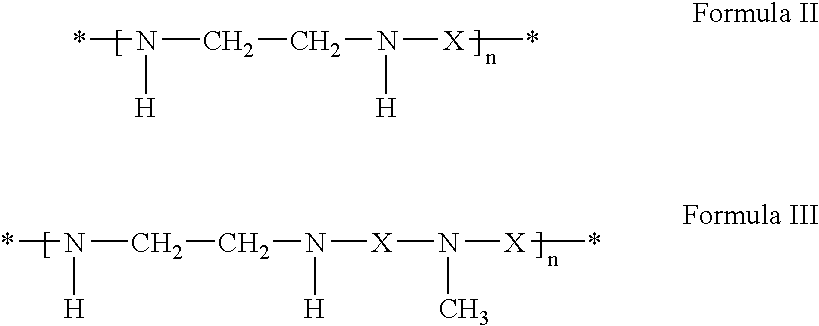Novel non-chrome metal treatment composition
a technology of non-chrome metals and compositions, applied in the direction of superimposed coating process, liquid/solution decomposition chemical coating, manufacturing tools, etc., can solve the problem of significant waste treatment process solid sludge discharg
- Summary
- Abstract
- Description
- Claims
- Application Information
AI Technical Summary
Benefits of technology
Problems solved by technology
Method used
Image
Examples
example 1
General Preparation Method of the Phosphonomethylated Polyamine
[0035] To a suitable reaction vessel equipped with a mechanical stirrer, thermocouple, addition ports, nitrogen sparge, and a water-cooled condenser is charged a 30 wt % solution of 1,6-hexamethylenediamine. The solution is sparged with nitrogen to inert the reactor, then the vessel is configured to have a nitrogen blanket. The reactor contents are then heated to 95±2° C. and epichlorohydrin is added in portions until a significant increase in the batch viscosity is observed. The total amount of epichlorohydrin utilized is typically 83 mole % of the 1,6-hexamethylenediamine charge. The epichlorohydrin portions are 50%, 25%, 15%, then 5% of the theoretical total until the desired viscosity is achieved. The first epichlorohydrin portion is charged over a 1-hour period, and that addition rate is maintained for the next two additions. All additions thereafter are added shot wise. The batch is held at temperature for 15-20 m...
example 2
Metal Passivation Demonstration
[0037] Test panels of G70 / 70 hot dipped galvanized (HDG) from ACT Laboratories and Galvalume® from Steelscape Inc. were prepared by spray cleaning with 3 wt % of an aqueous alkaline surfactant product (GE Betz Kleen 132), rinsed with tap water followed by DI water, then dried. A solution consisting of 15.0 wt % of the phosphonomethylated polyamine compound of Example 1, 8.5 wt % of 75 wt % aqueous phosphoric acid, 6.3 wt % of 26 Be Ammonium Hydroxide, 6.0 wt % of 60 wt % aqueous fluotitanic acid, 1.0 wt % Silquest A-1230 (a polyalkyleneoxide alkoxysilane commercially available from GE Silicones), and the balance water was applied to the panels utilizing a reverse roll coater. The treated panels were then dried in an oven at 450° F. to peak metal temperatures (PMT) of 200° F. The average coating weight of the panels were determined by measuring the Ti count expressed as mg / ft2: 9.16 for the HDG sample set and 6.60 for the Galvalume® set. The treated pa...
example 3
Metal Passivation Demonstration
[0041] As in Example 2 except the Silquest A-1230 was substituted with an equal weight amount of Silquest A-1100 (a aminopropyl alkoxysilane commercially available from GE Silicones). In this example the four Galvalume® panels each (average coating weight 5.98 mg Ti / ft2) were dried to a PMT of 150° F. and 200° F. and evaluated for NSS as well as the QCT Condensing Humidity test according to ASTM D-4585 and an internal wet pack test (WPT, a minimum of 6 wetted panels with the treated side facing each other are stacked under 15 ft / lb in2 pressure and placed in a 100% humidity cabinet at 100° F. and are evaluated periodically for the appearance of rust, 0% rust=perfect) to simulate storage of coil under humid conditions. The results of this testing summarized in Table 4 demonstrate the robustness of the phosphonomethylated polyamine formulation of the present invention with regard to cure temperature.
TABLE 4Galvalume ® PMT vs. % Black Rust (BR) & % Whi...
PUM
| Property | Measurement | Unit |
|---|---|---|
| wt % | aaaaa | aaaaa |
| temperature | aaaaa | aaaaa |
| temperatures | aaaaa | aaaaa |
Abstract
Description
Claims
Application Information
 Login to View More
Login to View More - R&D
- Intellectual Property
- Life Sciences
- Materials
- Tech Scout
- Unparalleled Data Quality
- Higher Quality Content
- 60% Fewer Hallucinations
Browse by: Latest US Patents, China's latest patents, Technical Efficacy Thesaurus, Application Domain, Technology Topic, Popular Technical Reports.
© 2025 PatSnap. All rights reserved.Legal|Privacy policy|Modern Slavery Act Transparency Statement|Sitemap|About US| Contact US: help@patsnap.com



